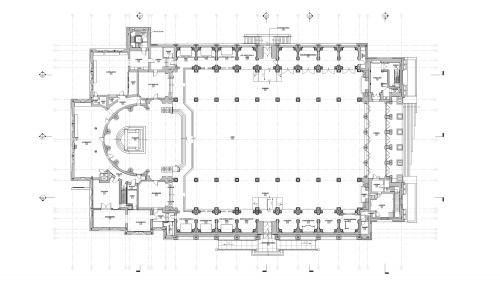As-Built Documentation
by Yuriy Alex Kulchytsky Head of VDC ServicesAs-built documentation plays a crucial role in the construction industry, ensuring accuracy and efficiency in project execution. By providing a detailed record of how structures were built compared to initial designs, this documentation aids in maintenance, renovations, and future development. Understanding the importance of maintaining up-to-date records can prevent errors, streamline processes, and enhance communication among project stakeholders.
What Are As-Built Drawings?
As-built drawing meaning is a revised set of drawings submitted by a contractor upon completion.
These are detailed records created during or after construction, depicting the precise dimensions, locations, and configurations of built structures. They serve to document any deviations or modifications from the original plans made during the construction process. These drawings encompass various elements such as structural components, utilities, and architectural features. As-built drawings provide crucial insights for future maintenance, renovations, or expansions. They facilitate effective communication among project stakeholders and aid in decision-making processes.

Importance of Accurate As-Built Documents
Enhancing Project Efficiency
These documents serve as a roadmap for future maintenance, renovations, or expansions. When contractors and engineers have access to accurate as-built records, they can make informed decisions quickly, reducing delays and errors during subsequent phases of a project.
Having detailed as-built documentation ensures that any modifications or repairs can be carried out efficiently without the need for extensive investigations or guesswork. For instance, if a building's electrical system needs an upgrade, having accurate records of the existing layout can significantly streamline the process. This not only saves time but also minimizes disruptions to daily operations.
Legal and Compliance Matters
Accurate as-built records are essential for legal and compliance purposes, serving as evidence of the completed work according to specifications and regulations. In the event of disputes or litigation, these documents act as tangible proof of what was constructed versus what was initially planned. This can help resolve conflicts swiftly and avoid costly legal battles.
Moreover, precise as-built documentation is vital for ensuring that structures comply with building codes and safety regulations. By maintaining up-to-date records of all modifications and installations, property owners can demonstrate that their buildings meet the required standards set by authorities. This not only protects occupants but also shields owners from potential fines or penalties due to non-compliance.
Updating and Maintaining As-Built Records
Process Overview
When updating as-built documentation, it is crucial to systematically incorporate any modifications made during the construction process. This involves revising existing records to accurately reflect the final state of a project. By ensuring that all changes are documented promptly, companies can maintain up-to-date and reliable information for future reference.
Regularly updating as-built records involves capturing details such as alterations to walls, additional installations, or changes in the original job specifications. This process ensures that the documentation remains reflective of the actual physical conditions of a structure. Companies often employ dedicated personnel responsible for overseeing these updates to guarantee accuracy and completeness.
Challenges Faced
Maintaining accurate as-built documentation poses several challenges over time. One common issue is the lack of consistency in recording changes, leading to discrepancies between the actual site conditions and documented information. Incomplete or outdated records can result in confusion during future projects, impacting both customers and internal operations.
Another challenge lies in managing multiple versions of as-built documents, especially in large-scale projects with numerous revisions. Keeping track of these iterations can be cumbersome, increasing the risk of errors or omissions within the records. To address these challenges, companies must establish robust protocols for organizing and storing documentation effectively.
Protocols for Maintenance
Establishing protocols for regular maintenance and updates of as-built records is essential for ensuring data accuracy and accessibility. Companies can implement standardized templates for documenting changes consistently across projects. By assigning clear responsibilities to designated staff members, organizations can streamline the revision process and minimize errors.
Moreover, utilizing digital tools and software solutions can enhance the efficiency of updating as-built records. These technologies provide features such as version control, audit trails, and automated notifications for upcoming revisions. By leveraging these tools, companies can improve the overall quality and reliability of their documentation practices.
Utilizing As-Built Documentation in Project Management
Planning Efficiency
Accurate construction documentation serves as a crucial foundation for project planning. By utilizing as-built documentation, project managers can ensure that the initial project plans align with the actual physical structures on-site. This alignment minimizes errors, reduces rework, and enhances overall project efficiency.
As-built records provide real-time insights into the current state of a project, enabling project managers to make informed decisions promptly. By referencing these documents, project teams can identify any deviations from the original plans and address them proactively. This proactive approach helps in maintaining project timelines and budgets effectively.
Monitoring Progress and Identifying Discrepancies
Projects often encounter unforeseen challenges during execution. As-built documentation plays a vital role in monitoring project progress and identifying discrepancies between planned and actual outcomes. Through regular updates to these records, project managers can track changes accurately and assess their impact on the overall project scope.
By comparing initial blueprints with updated as-built drawings, project teams can pinpoint areas where adjustments are needed. This detailed analysis ensures that any deviations are addressed promptly to prevent delays or cost overruns.
You've learned the vital role accurate as-built documentation plays in project success. By understanding how to achieve and maintain documentation precision, you pave the way for smoother project management. Remember, utilizing these records effectively can be a game-changer in your construction endeavors. So, keep those documents updated and readily accessible to streamline your operations.
Sponsor Ads
Created on Mar 15th 2024 04:45. Viewed 80 times.



